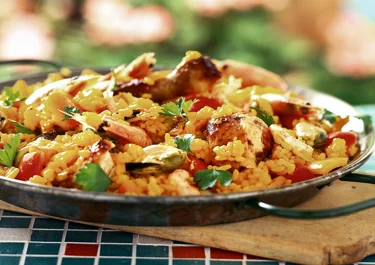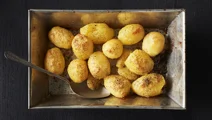Paella

Recipe for Spanish paella: colourful and wonderfully delicious! Here with saffron, prawns and arborio rice. Cook the paella in a large wok, starting with the rice before adding the chicken, seafood, and vegetables. Top with parsley and serve the paella straight from the wok.
Ingredients
|
1
Yellow onion
|
|
|---|---|
|
2
Garlic cloves
|
|
|
14⅖ g
Butter for frying
|
|
|
¼ g
Saffron
|
|
|
200 g
Arborio rice
|
|
|
500 ml
Water
|
|
|
45 ml
Chicken stock
|
|
|
40 g
Butter
|
|
|
1
Lime, squeezed juice
|
|
|
1 tsp
Sambal oelek
|
|
|
500 g
Large prawns with shell
|
|
|
1
Grilled chicken
|
|
|
1
Pepper
|
|
|
3
Tomatoes
|
|
|
225 g
Mussels, canned
|
|
|
13 g
Coarsely chopped fresh parsley
|
Instructions
Paella
What is the secret to a good paella?
The pan, the rice, and the broth. A traditional pan is thin, wide, and shallow to create that signature crust the dish is known for. Because rice is the star of the show, choose the highest quality you can find. Short-grained varieties work best like Bomba (the most traditional), Arborio (the easiest to find), or Calrose rice. The grains will absorb every flavour, making your broth the last secret ingredient. A homemade stock is highly recommended and will transform your paella into an unforgettable meal.
Do you cook paella on high or low heat?
A medium-low stovetop heat will allow you to control the cooking process and prevent the rice from scorching or burning. Alternatively, go full traditional by cooking your dish on an open wood fire. Not only will this provide an even heat source for the perfect cooking temperature, but it will also add an authentically Spanish flair and flavour to your creation.
How do I stop my paella from sticking?
To the contrary, you want it to stick a little to create the coveted socarrat: that crust of caramelised rice that creates a near perfect contrast to the rest of the dish. The trick is to know when the rice should and shouldn’t stick. While it’s cooking, shake the pan frequently to prevent sticking. In the last 5-10 minutes, slightly increase the heat and leave the dish to develop that characteristic crunchy layer.
How do you make the bottom of a paella crispy?
In the last 5-10 minutes of cooking time (check that most of the liquid has been absorbed and the rice is fully cooked) slightly increase the heat and keep your nose and ears on high alert: the perfect socarrat (the coveted crust of caramelised rice that is traditionally reserved for guests of honour) is when you start to hear crackling noises and notice a slightly toasted and nutty aroma.
Do you cover paella while cooking?
Traditionally, no. In fact, paella pans do not come with lids at all, and a kitchen towel is often used to give the dish a covered rest before serving.
The most quintessential Spanish dish
Vibrant and colourful with a cuisine that is as fantastically flamboyant as its culture: there are many reasons why Spain is the second most popular tourist destination in the world. This authentic paella recipe will transport you to the heart of Valencia with saffron-tinted rice, delicately sweet seafood, and fresh vegetables in every satisfying bite.
Spain’s unofficial national dish
Named after the paellera pan, the dish originated in Valencia, one of Spain’s major rice producing regions on the east coast. As the story goes, local farmers would create the dish from rice and other easily accessible ingredients like rabbit, snails, tomatoes, and onions. It quickly spread beyond the rice fields with chicken and fresh seafood soon added as star ingredients. Today, many consider it Spain’s national dish with few disagreeing that it is, by far, the country’s most popular culinary creation.
Drinks that go well with paella
For an authentic Spanish experience, pair your feast with a sweet and fruity sangria or crisp Cava as a bubblier and elegant alternative. White or red wine also compliment the dish very well and, as the second largest wine producer in the world, you won’t have to look far for the perfect local match. For an equally satisfying alcohol-free pairing, try granizado de limón (iced lemonade) or a non-alcoholic sangria.
Seafood paella and other variations
Traditionally speaking, there are three main types: the original paella valenciana that includes rabbit, chicken, duck and/or snails; paella de marisco that features seafood; and paella mixta which is a surf and turf combination.








